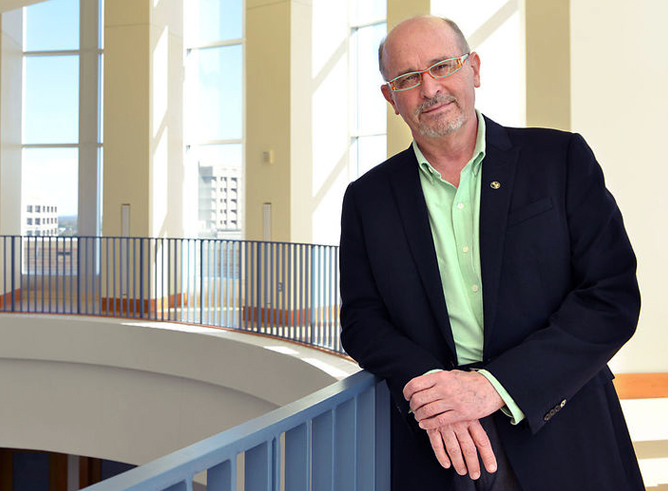
Nicholas B. Suntzeff, University Distinguished Professor and Regents Professor of Physics and Astronomy at Texas A&M University, has been elected as a 2023 Fellow of the American Astronomical Society (AAS), the major organization of professional astronomers, astronomy educators and amateur astronomers in North America.
The AAS Fellows Program was created in 2019 to recognize original research and publications, innovative contributions to astronomical techniques or instrumentation, significant contributions to education and public outreach, and noteworthy service to astronomy and the Society itself.
Suntzeff, an observational astronomer specializing in cosmology, supernovae, stellar populations and astronomical instrumentation, is one of 22 AAS members honored in 2023 for enhancing and sharing humanity’s scientific understanding of the universe through personal achievement and extraordinary service to the astronomical sciences and to the AAS. Each will receive a certificate and a lapel pin.
“It is a joy to celebrate the dedication and accomplishments of these extraordinary members of our community,” said AAS President Kelsey Johnson, a professor in the Department of Astronomy at the University of Virginia. “We are so fortunate to have colleagues and role models who have invested so deeply in moving astrophysics forward.”
Suntzeff is cited “for his transformational leadership in the foundation of supernova cosmology, the discovery of the accelerated expansion of the universe, and precision measurements of the Hubble–Lemaître flow; for his service to the national and international astronomical communities; for considerable efforts on behalf of human rights, especially the LGBTQ community, both within astronomy and globally; and for establishing the astronomy program at Texas A&M University."
Suntzeff joined the Department of Physics and Astronomy in 2006 as director of the Texas A&M astronomy program and the inaugural holder of the Mitchell-Heep-Munnerlyn Chair in Observational Astronomy. A member of the George P. and Cynthia Woods Mitchell Institute for Fundamental Physics and Astronomy, he was appointed in 2013 as a university distinguished professor, the highest level of achievement for faculty recognized as pre-eminent authorities in their fields. In 2017, he was named a Regents Professor by The Texas A&M University System, a perpetual title celebrating employees who have made exemplary contributions to their university or agency and to the people of Texas.

Prior to coming to Texas A&M, Suntzeff spent 20 years as a staff astronomer at the National Optical Astronomy Observatory Cerro Tololo Inter-American Observatory (CTIO) in La Serena, Chile, rising to the rank of associate director for science at NOAO. In 1994 with Dr. Brian Schmidt, he co-founded the High-Z Supernova Search Team that in 1998 discovered acceleration and the presence of dark energy in the universe. The finding was honored as Science magazine’s “Scientific Breakthrough of the Year” for 1998 across all science disciplines and earned a host of prestigious international awards, including the 2006 Shaw Prize, the 2007 Gruber Prize in Cosmology, the 2011 Nobel Prize in Physics and the 2015 Breakthrough Prize in Fundamental Physics. He was also a co-founder of the Calan/Tololo Supernova Survey that established Type Ia supernovae as the most precise markers for measuring cosmological distances.
“I have been lucky to have lived during a time of great opportunities in my 45 years as an astronomer and to share these discoveries with my creative collaborators," Suntzeff said. "As I look back, I am most proud of the success we have had in establishing an astronomy program at Texas A&M. With the support of the university and the generous support of the Mitchell family, the Munnerlyn family and Ersen Arseven '74, we have a world-class faculty in astronomy and astrophysics with an exciting future using the Giant Magellan Telescope.”
Suntzeff's previous awards include the 2013 Bush Excellence Award for International Research and a 2012 Texas A&M Association of Former Students Distinguished Achievement Award in Research. A past vice president of the American Astronomical Society, he spent most of 2011 in Washington, D.C. as Texas A&M’s first-ever National Academy of Sciences Jefferson Science Fellow, advising the U.S. State Department on scientific issues as they relate to international diplomacy.
Suntzeff earned a bachelor’s degree in mathematics from Stanford University in 1974 and a Ph.D. in astronomy and astrophysics from the University of California, Santa Cruz, and Lick Observatory in 1980.
To learn more about Suntzeff and his teaching, research and professional service accomplishments, visit https://physics.tamu.edu/directory/nsuntzeff/.
For more information on the American Astronomical Society or the AAS Fellows Program, visit at https://www.aps.org.
See a profile on Suntzeff's pioneering career from Battalion reporter Jack Lee '24.
